Camp Wawayanda, used to be a boy’s camp in Western New Jersey at Andover. They’re now in the Catskills as part of the Frost Valley YMCA.
This was my experience as a boy for four summers, sometime around 1943 to 1946 – war years, some of them. Mostly we went to camp on the DL & W railroad on a steam train; gas and tires were hard to come by in those days. They were rationed. After the war, of course, it was different.
I also served on the staff for most of my high school and college years. Anyone out there remember those years? Or me? I’d like to hear from you. Send me a note.
Here are some pictures from my years, and some before my years.
Recent notes and pictures from some other Wawayanda people, see the “letters” page.
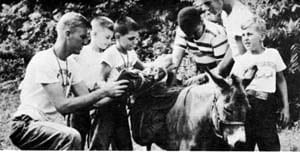
That’s Jim Wait on the left. He ran the “campcraft” activity for a few years. Jim served several years at Andover, and then did at least one year at the Johnsonburg site. The donkey was called “JED”. Interesting that the camp director that year was J. Edward Dodds.
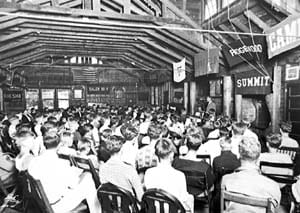
The dining lodge at the Andover site. Of course this is not the way we usually saw it. It was usually full of big round tables and the hustle and bustle of the entire camp eating a meal. Fireplace and kitchen are to the right, the wonderful big wraparound porch to the left.
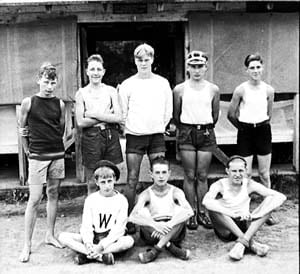
Anyone recognize themselves out there?
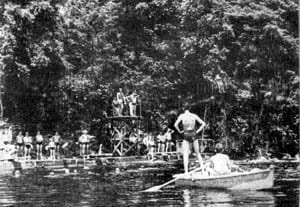
I don’t see the slides in this photo. I guess they came and went, maybe out for repairs.
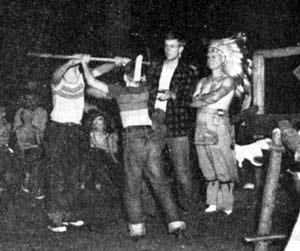
Campfire program at the main council ring in the 50’s. That’s Wendell “Wendy” Rasco, resident imitation indian. I’m to his right (assistant resident imitation indian), helping to supervise the game, whatever it was!
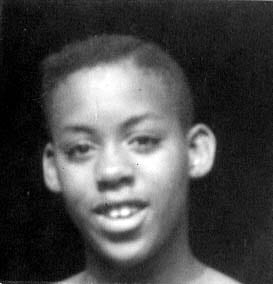
Art Lockett was a junior counselor in my village (Forest) for a year, he slept in my cabin (#4). He was from Montclair, I recall, because he would frequently break out in the Montclair “fight” song. That was the early years of integration, which came in around 1950. Art’s nick-name was “Dr. Sunshine”, because he was the infirmary aid a couple of years. See Art in the 1956 staff photo at the bottom of the page.
New York Times:
LOCKETT-Arthur C. On September 18, 1999. Of Montclair, N.J. Beloved brother of Lowell B. Lockett. Uncle of Andrea M., David L. and Edward B. Lockett. Nephew of Eleanor Richardson. Funeral service Saturday, September 25th, 11AM at Saint Luke’s Episcopal Church, South Fulton Ave. and Union St, Montclair, N.J. Interment Rosedale Cemetery, Orange, N.J. Inquiries Martin’s Home for Service, 48 Elm St, Montclair. In lieu of flowers, please make donations to Hilda & Levi Lockett Memorial Fund, C/O Lawrence Academy, Box 992, Groton, MA. 01450.

Picture recently sent to me :
Hi, I came across your Waywayanda blog awhile ago, and was so delighted to see a picture of my Uncle Art (aka “Dr. Sunshine”) there. I’m writing to add another photo of him with my father Lowell, his older brother who also was a camper there.
Sadly, my father died this week.
Best,
Andrea Lockett
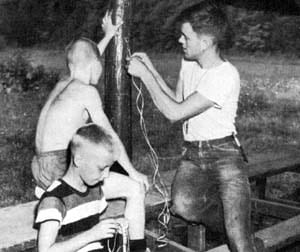
How’s your hair now, Red?


1953 staff photo, Andover. Earl Armstrong in the front. Right behind him, to his left, Bob Herbst. In the third row, Bob Slater on the right end of the row (his right), and Chris Jones (me) second from the left end of the row. Nurse Phyllis Ford in the center.

Staff, 1954, Andover. Earl Armstrong in the center. Bob Herbst in the second row next to the nurse (Phyllis Ford). I’m in there somewhere!
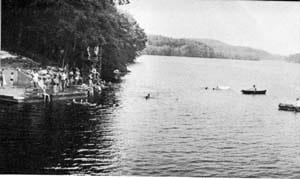
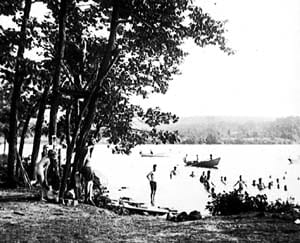

Group picture in front of the dining lodge. The banner says “Wawayanda” in the middle, JBC in the upper left, and YMCA in the lower right.
That was a great porch, overlooking the open grassy area and the lake. The camp store was around the corner, on the South end of the building.

The main council ring. Indian dances, fires, contests, songs, stories, … These were usually held at night, with roaring fire in the center. Maybe this particular photo was staged for the publicity camera.
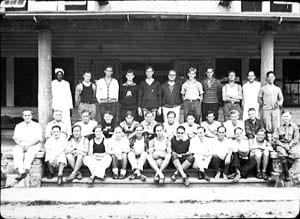
I’ll provide a larger copy if you think you know someone!
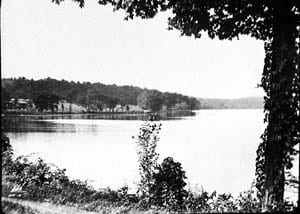
View from the south end of the lake, where the road into camp passes, this is almost from the farmhouse porch. Looks similar today, except today we don’t see cabins. Totem village, perhaps Forest lodge, is visible in this photo.

The swim dock. Artificial respiration. I don’t think this is the recommended method any more, but it was in those days. The 8 foot tower is visible in the background.
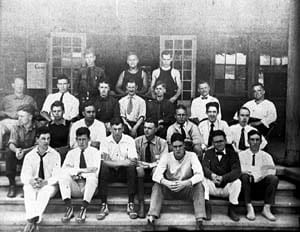
A staff photo from the early years. That’s Charles R. Scott right in the center. I guess you’d have to call him one of the founding fathers. Charles died while visiting camp in the summer of 1954. A good way to go: suddenly and in the place where you love to be.
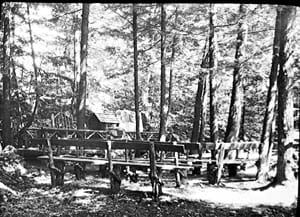
Here’s Kilbourne chapel more or less as I remember it. A very pretty spot. Seating on benches with back-rests. Nice shade. A lectern can be seen (left center). Preaching, singing hymns, prayers, … There was a set of chimes which were often assembled for service on sunday morning, and one on my campers used to play them (David Chamberlain), as I recall. Also they brought up a small foot-powered reed organ.
There was a truck ride to a local church for Catholics (they were a small minority). There were very few Jewish campers; I remember one camper and one staff member.

Cabin row. Before my time. Probably 20’s or 30’s. Canvas walls. There were a few of these left in Pioneer and Hemlock village when I was a camper. In my time, most of the cabins were enclosed. They were arranged in small village groups. Each cabin held four double decker bunks; you could squeeze in an extra cot if you had to, but that made it really crowded.

